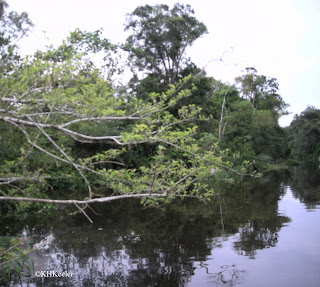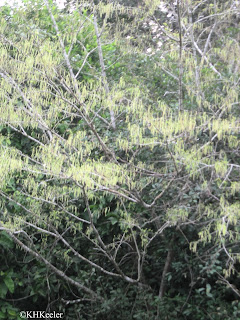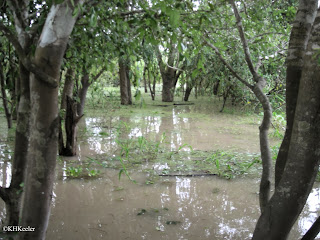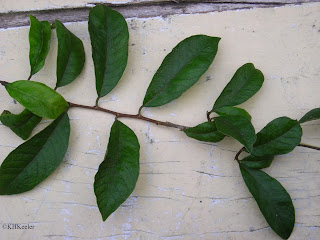 |
| old fustic, dyer's mulberry, Maclura tinctoria |
It has a curious history.
First, old fustic is a plant from the Americas, discovered after 1492 in the forests of tropical America.
Shortly after Columbus' voyages, European explorers in the Americas discovered the wood of old fustic trees made a good yellow dye. It seems a little weird that with 1,000s of trees in the American tropics explorers would know or care about old fustic. However, logwood and brazilwood were making the fortunes of sailors, since they produce highly-sought purple-gray and red dyes respectively, so there was probably a lot of dye-wood prospecting in the early 1500s.
 |
| two purple shades from logwood (blue from indigo) |
Clearly related to mulberries, the tree was given the scientific name Morus tinctoria. Morus is the genus of mulberries, tinctoria indicates that it is colored, that is, a dye. Its wood make a stable yellow dye. So calling it dyer's mulberry was a good descriptive common name.
 |
| old fustic, dyer's mulberry, Maclura tinctoria, new leaves |
However, it was also called old fustic. The logic of this is less clear to me.
Young fustic is a sumac, specifically the Venetian sumac or wig tree, Cotinus (formerly Rhus) coggygria (cashew family, Anacardiaceae), a shrub or small tree found in southern Europe (photos). The word "fustic" apparently comes from the Arabic word for bush. Young fustic is a dye plant that produces yellow from its stems and wood. Although widely used in the European Middle Ages, alone and in combination with other dyes, medieval European sources all described it as a very poor dye because it had "no colorfastness whatsoever." That is, the nice initial color faded very quickly. Nevertheless it was widely used, I suppose because it was a readily available shrub or because it produced shades difficult to get from other dyes.
Old fustic was presumably named because it produced colors that resembled those of the familiar fustic. Another possibility is that of the yellow dyes in use in 1500, only young fustic was made from wood chips. So the new plant could have picked up the fustic name because it was a dye from wood not leaves. Why the young fustic is the one used for centuries in Europe and the old fustic is the one discovered in the New World remains a mystery to me.
 |
| weld, Reseda luteola |
 |
| old fustic, dyer's mulberry, Maclura tinctoria. flowering |
 |
| flooded Amazon forest |
Old fustic made a rather bland yellow without mordant, but with alum or other mordants, a better color. (Photo below) Moreover, it was used as the base with other yellow, beige, or orange dyes, and combined with logwood to make a popular shade of black.
Hundreds of thousands of tons of old fustic were shipped to Europe and the United States during the last 500 years. By 1830, at least 5,900 tons were recorded as annually imported to Britain. About 1905, the annual imports to the United States were more than 4,000 tons. During the First World War, old fustic imports to the U.S. increased to over 14,000 tons per year because synthetic dyes from Europe were interrupted. By that time, army uniforms were no longer red and blue, but increasingly buff and khaki. These are colors easily obtained from old fustic, so its use increased during World War I.
 |
| yarns dyed with old fustic |
The scientific name of old fustic has changed twice this century. First it was decided it was too different from edible mulberries to be in that genus, so it became Chlorophora tinctoria. A more recent reevaluation has put it in the same genus as the North American tree Osage orange, Maclura pomifera. Osage orange is a fine dye plant too, with the same dye chemistry as old fustic. At least two other members of Maclura, the Asian Maclura cochinensis and Maclura brasiliensis of South America, have been used by local people as yellow dye plants. All share the important dye morin (3,5,7,2',4',5,7-pentahydroxyflavone). Currently the scientific name of old fustic, dyer's mulberry, is Maclura tinctoria, still in the mulberry and fig family, Moraceae.
Unlike most of the natural dyes, old fustic continues to be a commercial dye. It is also used in quantity in the tanning industries, as part of blends to produce particular shades of leather. In addition, it is sold as an exotic wood for cabinetry, usually as Argentine Osage orange. So, it is still being sold commercially on a large scale today.
Consequently it is in danger of being seriously over-exploited. The trees grow on disturbed sites along rivers and streams and on sea shores. It was quite common, across Central and northern South America, but its preferred habitat made it easy to harvest. Apparently the seeds are often infertile, which has retarded raising it in plantations. Different sources I checked, none of them satisfyingly detailed, described it as endangered, exported in large quantities and raised sustainably. Probably all are true somewhere, but developing sustainable production seems essential.
 |
| flooded Amazon forest |
My pictures of old fustic are from the Peruvian Amazon. On a Smithsonian tour, we took small boats through areas in the upper Amazon where river levels rise 20 feet in the rainy season. It was slightly before the peak of the water levels so the trees were more than half submerged. We took little boats into otherwise inaccessible areas. The guides pointed out noteworthy plants when no colorful bird was in sight. They gave one tree's English name as the toothache tree and described the use of the sap to relieve a toothache. Then they added it was Maclura tinctoria. I reacted with geeky delight. Not very often I stumble on a historically important plant by accident. In its native habitat!
 |
| old fustic branch on the bottom of the boat |
Comments and corrections welcome.
References
Berg, C.C. 1986. The delimitation and subdivision of the genus Maclura (Moraceae). Proc. K. Ned. Akad. Vwet, Sec. C. Biol. Med. Sci. 89: 241-247.
Cardon, D. 2007. Natural Dyes. Archetype Publications, New York.
J.L.Castner,S.L.TimmeandJ.A.Duke.AFieldGuideToMedicinalandUseful
Plants of the Upper Amazon. Feline Press, 1998 http://odiet.ch/guatemala/files/jungle.pdf
Kaastra, J. C. 1972. Revision of Chlorophora (Moraceae) in America. Acta Bota. Neerl. 21(6); 657-670.
Septhum, C., V. Rattanaphani and S. Rattanaphani. 2007. UV-VIS spectroscopic study of natural dyes with alum as a mordant. Suranaree J. Sci. Technology 14(1): 91-97.
My blog on dyeing with plants : Dye plants--yellows from many sources
Kathy Keeler
awanderingbotanist.com
Kaastra, J. C. 1972. Revision of Chlorophora (Moraceae) in America. Acta Bota. Neerl. 21(6); 657-670.
Septhum, C., V. Rattanaphani and S. Rattanaphani. 2007. UV-VIS spectroscopic study of natural dyes with alum as a mordant. Suranaree J. Sci. Technology 14(1): 91-97.
My blog on dyeing with plants : Dye plants--yellows from many sources
Kathy Keeler
awanderingbotanist.com
No comments:
Post a Comment